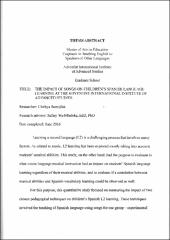| dc.description.abstract | Learning a second language (L2) is a challenging process that involves many
factors. As related to music, L2 learning has been explored mostly taking into account
students' musical abilities. This study, on the other hand, had the purpose to evaluate to
what extent language musical instruction had an impact on students' Spanish language
learning regardless of their musical abilities, and to evaluate if a correlation between
musical abilities and Spanish vocabulary learning could be observed as well.
For this purpose, this quantitative study focused on measuring the impact of two
chosen pedagogical techniques on children's Spanish L2 leaming. These techniques
involved the teaching of Spanish language using songs for one group-experimental
group and not using songs for the other group-comparison group. Both pedagogical
approaches, though, were based on the Communicative Language Teaching approach.
This quasi-experimental design study had 46 participants. These participants were
children aged 8 to 11 years old from the Adventist International Institute of Advanced
Studies' community, randomly divided into two 23-student groups. The study included a
musical abilities test, a Spanish pretest, 4 I -hour instruction sessions, and a Spanish
posttest at the end, for a total of 6 research sessions.
After the data collection, test scores were compared using independent samples t-tests to evaluate if there was a statistical difference between the experimental and
comparison groups regarding the Spanish vocabulary tests. Results showed a nonsignificant
difference between the research groups' performance both in the Spanish
vocabulary pre- and post-test. This result continued the tendency seen in similar studies
done. The literature on the topic was consulted, and songs were proposed as one of many
pedagogical techniques to be used in the L2 classroom.
This research found, nevertheless, a Pearson's test strong positive correlation
between participants' musical abilities and L2 learning. This result presents one of the
first empirical evidences to correlate these two variables as a result of a written test.
Suggestions for parents, teachers, and students highlighted that given the correlation
between musical abilities and L2 learning, music, and songs can be particularly useful for
some L2 students. As the topic was not exhausted, further research suggestions were
offered to continue this line of investigation connecting L2 learning and music. | en_US |

